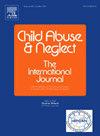A dyadic analysis of childhood violence exposure through parental discipline in a population-based cohort
IF 3.4
2区 心理学
Q1 FAMILY STUDIES
引用次数: 0
Abstract
Background
Few studies have examined whether mothers' and fathers' disciplinary tactics may overlap or differ. Examination of both parents' disciplinary behaviors will contribute to explain potential variation in associated violence risk.
Objective
This study aims to assess if parental discipline used towards children in childhood and adolescence are individual or dyadic behaviors.
Participants and setting
We used data from Portuguese Generation XXI cohort participants (n = 6110).
Methods
Parental discipline was reported at ages 7 and 13 using Parent-Child Conflict Tactics Scale. A score was developed for each dimension. Actor–partner Interdependence (APIM) and Common-Fate (CFM) Models estimated effects of individual and shared decisions on discipline from ages 7 to 13.
Results
APIM revealed that non-violent discipline, psychological and corporal aggression from ages 7 to 13 were actor-oriented behaviors (βactor = 0.131, 95%CI: 0.107;0.156 vs. βpartner = −0.006, 95%CI: −0.031;0.018; βactor = 0.188, 95%CI: 0.160;0.216 vs. βpartner = 0.005, 95%CI: −0.022;0.032; βactor = 0.185, 95%CI: 0.159;0.211 vs. βpartner = 0.014, 95%CI: −0.012;0.039, respectively). Severe physical assault was couple-oriented (βactor = βpartner = 0.060, 95%CI: 0.032;0.089). CFM revealed significant associations between non-violent discipline, psychological and physical aggression from ages 7 to 13, both individually and dyadically. Regarding severe discipline, dyadic latent variable showed a significant association (βshared = 0.138, 95%CI: 0.066;0.210).
Conclusions
Independently of the actor, the use of non-violent discipline, psychological aggression and corporal punishment in childhood predicted their use in adolescence. The consistent use of the most severe discipline was a parental shared decision. Research should consider parental discipline as a factor influencing children's risk of violence exposure and impact on health and development.
基于人群的队列中通过父母管教对儿童暴力暴露的二元分析
很少有研究调查母亲和父亲的管教策略是否重叠或不同。对父母双方纪律行为的检查将有助于解释相关暴力风险的潜在差异。目的本研究旨在评估父母对儿童和青少年的管教是个体行为还是二元行为。参与者和环境我们使用了来自葡萄牙21代队列参与者的数据(n = 6110)。方法采用亲子冲突策略量表对7岁和13岁儿童的父母管教行为进行问卷调查。每个维度都有一个分数。参与者-伙伴相互依赖(APIM)和共同命运(CFM)模型估计了7至13岁儿童的个人和共同决策对纪律的影响。结果apim结果显示,7 ~ 13岁儿童的非暴力管教、心理攻击和身体攻击行为为行动者导向行为(β行动者= 0.131,95%CI: 0.107;0.156; β伴侣= - 0.006,95%CI: - 0.031;β演员= 0.188,95% ci: 0.160; 0.216与β伙伴= 0.005,95%置信区间ci:−0.022;0.032;βactor = 0.185, 95%CI: 0.159;0.211, βpartner = 0.014, 95%CI: - 0.012;0.039)。严重人身攻击以夫妻为导向(β行为人= β伴侣= 0.060,95%CI: 0.032;0.089)。CFM结果显示,7 - 13岁儿童的非暴力纪律、心理和身体攻击之间存在显著的个体和代际关联。在严格纪律方面,二元潜变量呈显著相关(β共享= 0.138,95%CI: 0.066;0.210)。结论与行为者无关,儿童时期非暴力管教、心理攻击和体罚的使用可以预测青少年时期的使用。始终如一地使用最严厉的管教是父母共同的决定。研究应考虑到父母管教是影响儿童遭受暴力的风险及其对健康和发展的影响的一个因素。
本文章由计算机程序翻译,如有差异,请以英文原文为准。
求助全文
约1分钟内获得全文
求助全文
来源期刊

Child Abuse & Neglect
Multiple-
CiteScore
7.40
自引率
10.40%
发文量
397
期刊介绍:
Official Publication of the International Society for Prevention of Child Abuse and Neglect. Child Abuse & Neglect The International Journal, provides an international, multidisciplinary forum on all aspects of child abuse and neglect, with special emphasis on prevention and treatment; the scope extends further to all those aspects of life which either favor or hinder child development. While contributions will primarily be from the fields of psychology, psychiatry, social work, medicine, nursing, law enforcement, legislature, education, and anthropology, the Journal encourages the concerned lay individual and child-oriented advocate organizations to contribute.
 求助内容:
求助内容: 应助结果提醒方式:
应助结果提醒方式:


